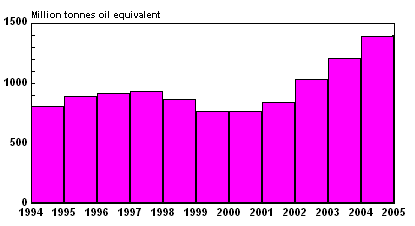Tiempo Climate Cyberlibrary
Global Energy Trends
- Tiempo archive
- Complete issues
- Selected articles
- Cartoons
- Climate treaty
- Latest news
- Secretariat
- National reports
- IPCC
About the Cyberlibrary
The Tiempo Climate Cyberlibrary was developed by Mick Kelly and Sarah Granich on behalf of the Stockholm Environment Institute and the International Institute for Environment and Development, with sponsorship from the Swedish International Development Cooperation Agency.
While every effort is made to ensure that information on this site, and on other sites that are referenced here, is accurate, no liability for loss or damage resulting from use of this information can be accepted.
|
The International Energy Agency and British Petroleum have released their latest annual reports on current trends in energy consumption. Newswatch editor Mick Kelly reports. |
According to the International Energy Agency (IEA), global greenhouse gas emissions could rise by 52 per cent by the year 2030 unless action is taken to reduce energy consumption. The IEA's World Energy Outlook for 2005 predicts that, if current trends continue, energy demand is set to rise by over 50 per cent over the next 25 years. Without extra investment in oil facilities, oil prices will rise substantially. "These projected trends have important implications and lead to a future that is not sustainable," according to IEA head Claude Mandil.
The IEA's medium- to long-term energy projections are generated using the World Energy Model. The model has been run under three different scenarios - the Reference Scenario, the World Alternative Policy Scenario (where importing nations take action to cut demand and change the pattern of fuel use) and the Deferred Investment Scenario (where producers delay spending, inadvertently or deliberately). The model analyses global and regional energy demand and supply prospects, the environmental impact of energy use and energy sector investment needs through to 2030.
Commenting on the projections, Klaus Toepfer, head of the United Nations Environment Programme, said that "this is a grim prognosis based on business as usual. So it must be a clear signal that, in order to avoid such a disaster, we must deploy technologies and adopt economic measures that are already available and feasible."
|
|
Primary energy consumption, China Data from 54th Statistical Review of World Energy |
British Petroleum (BP) has published the 54th Statistical Review of World Energy. As in last year's report, growing energy demand and developments in China dominate the 2005 review.
During 2004, global energy consumption grew by 4.3 per cent, the largest ever annual increase in global consumption in volume terms. Energy demand in China rose by 15.1 per cent during 2004 and, over the past three years, Chinese energy demand has increased by 65 per cent. China now consumes 13.6 per cent of the world's energy.
Global carbon emissions rose by 4.5 per cent during 2004. Disturbingly, this is the highest annual percentage increase since 1976 and the highest absolute increase on record.
Further information
The BP
Statistical Review of World Energy can be downloaded.
There is also a facility to generate custom
graphs of energy trends.
|
News sources |
|
Bright Ideas

General Electric plans to cut solar installation costs by half

Project 90 by 2030 supports South African school children and managers reduce their carbon footprint through its Club programme

Bath & North East Somerset Council in the United Kingdom has installed smart LED carriageway lighting that automatically adjusts to light and traffic levels

The United States National Oceanic and Atmospheric Administration and the American Public Gardens Association are mounting an educational exhibit at Longwood Gardens showing the link between temperature and planting zones

The energy-efficient Crowne Plaza Copenhagen Towers hotel is powered by renewable and sustainable sources, including integrated solar photovoltaics and guest-powered bicycles
El Hierro, one of the Canary Islands, plans to generate 80 per cent of its energy from renewable sources

The green roof on the Remarkables Primary School in New Zealand reduces stormwater runoff, provides insulation and doubles as an outdoor classroom

The Weather Info for All project aims to roll out up to five thousand automatic weather observation stations throughout Africa

SolSource turns its own waste heat into electricity or stores it in thermal fabrics, harnessing the sun's energy for cooking and electricity for low-income families

The Wave House uses vegetation for its architectural and environmental qualities, and especially in terms of thermal insulation

The Mbale compost-processing plant in Uganda produces cheaper fertilizer and reduces greenhouse gas emissions

At Casa Grande, Frito-Lay has reduced energy consumption by nearly a fifth since 2006 by, amongst other things, installing a heat recovery system to preheat cooking oil
Updated: May 15th 2015
